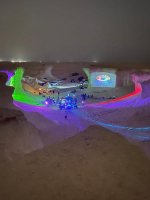Hi Everyone, I'm new to this forum and have been searching the internet recently for reviews on active 18"subs + 3-way tops combination. I'm just a weekend warrior and I live in the middle east where our crew puts on underground free parties in hidden desert locations (see pics for example). These events are often located in canyons or an abandoned quarry and can be up to 100-200 people. But even if the crowd is only 50 people, are goal is to have NICE quality sound because we're all music lovers and DJs who mostly play genres spanning techno, house, minimal, DnB, leftfield tech, funk, neo-soul, afrobeat, psytrance and hip-hop.
We're raising some funds to purchase new gear and top of my list currently is the following 18" sub/ 3-way full range pairs...
-JBL SRX series
-QSC kw series (with the newer 118 high power sub, not the 181)
-Yamaha DZR + DXS
-RCF 8004 + NX985
-EV ETX series
Where i live I know that QSC, Yamaha have local dealer we can go through instead of having to arrange expensive shipping, and we can go through a friend's company that brings in EVs.
We WILL be using the 3-way on its own without the sub for smaller parties, which is why this is of interest over a 2-way option. Besides, 3-ways generally sound very nice in the mids with the additional driver.
I've seen many great reviews of the yamaha DZR 315, but one question here is whether the DXS18 can really match this speaker with only 1600W peak power? How can they achieve 136spl at that power compared to others in the same class that generally are listed at 2000w or even a little more peak power? or is this just marketing BS? I know these are all great options but any feedback would be much appreciated because we are not able to go somewhere and actually listen to them in a shop of whatever.
We're raising some funds to purchase new gear and top of my list currently is the following 18" sub/ 3-way full range pairs...
-JBL SRX series
-QSC kw series (with the newer 118 high power sub, not the 181)
-Yamaha DZR + DXS
-RCF 8004 + NX985
-EV ETX series
Where i live I know that QSC, Yamaha have local dealer we can go through instead of having to arrange expensive shipping, and we can go through a friend's company that brings in EVs.
We WILL be using the 3-way on its own without the sub for smaller parties, which is why this is of interest over a 2-way option. Besides, 3-ways generally sound very nice in the mids with the additional driver.
I've seen many great reviews of the yamaha DZR 315, but one question here is whether the DXS18 can really match this speaker with only 1600W peak power? How can they achieve 136spl at that power compared to others in the same class that generally are listed at 2000w or even a little more peak power? or is this just marketing BS? I know these are all great options but any feedback would be much appreciated because we are not able to go somewhere and actually listen to them in a shop of whatever.



